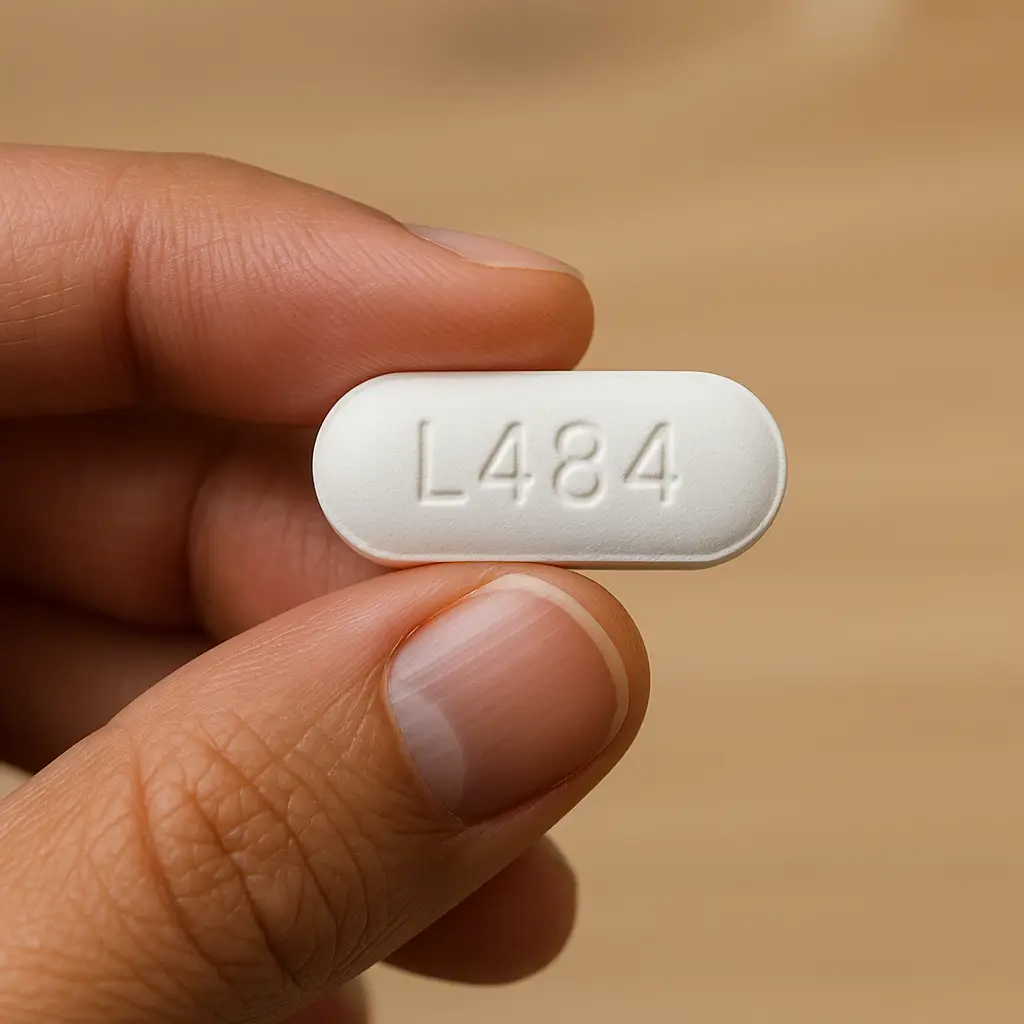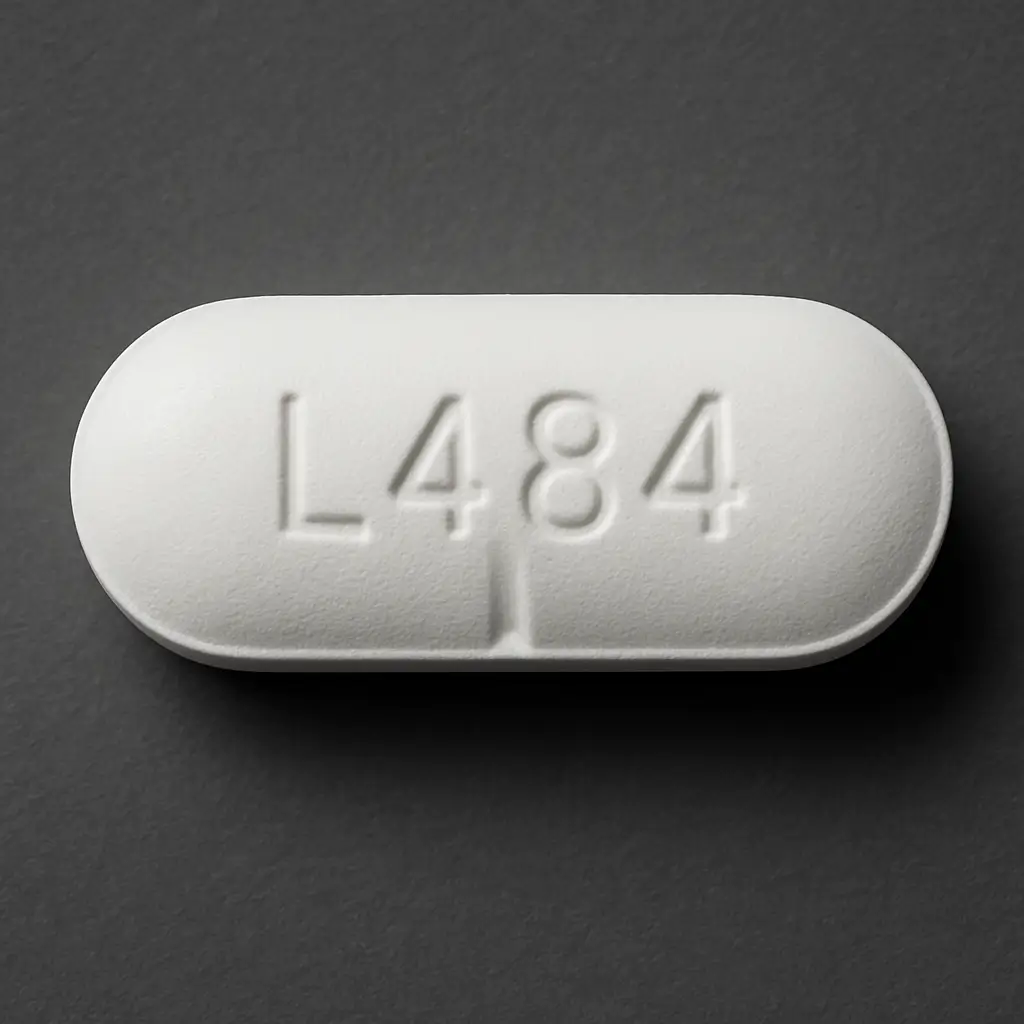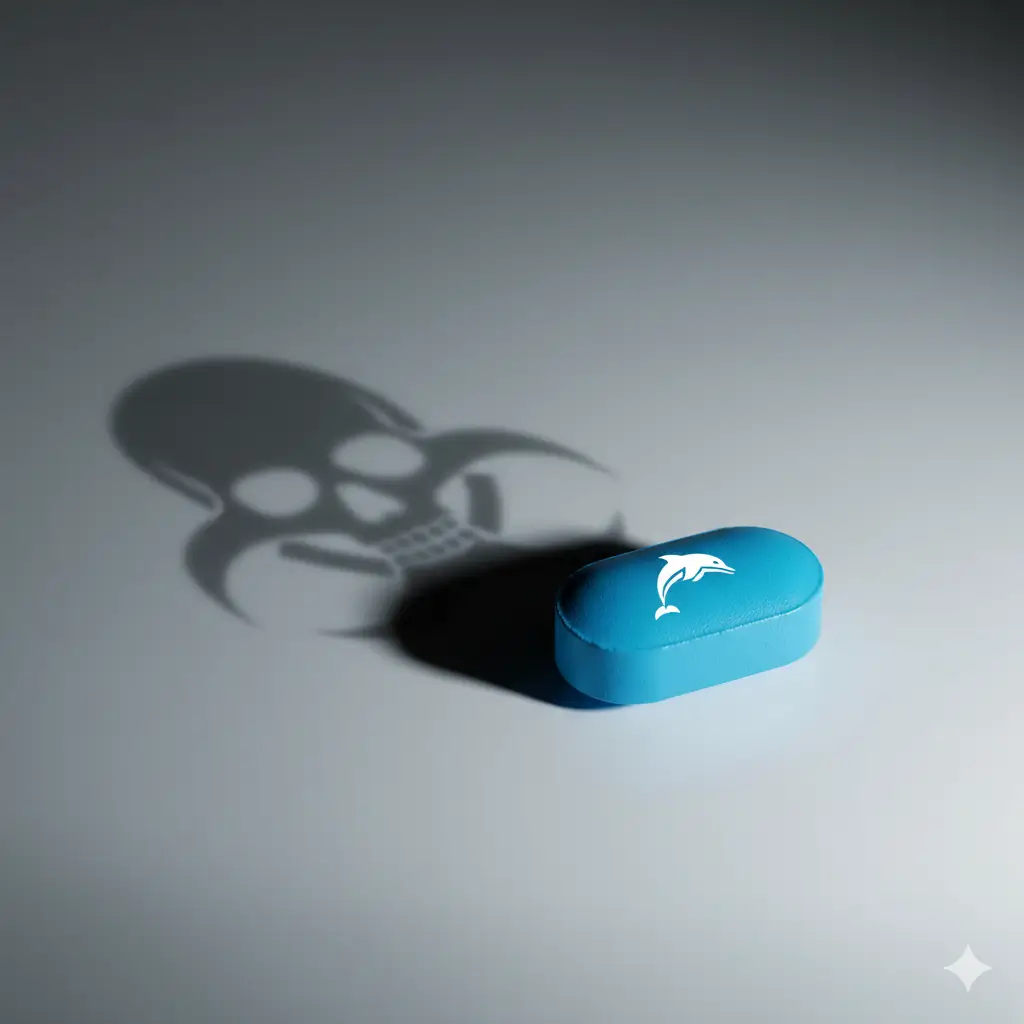The L484 pill is a small white, capsule-shaped (oblong) tablet marked with the imprint “L484” on one side. This pill has been identified as acetaminophen 500 mg, which is the active ingredient in many over-the-counter pain relievers like Tylenol Extra Strength drugs.com. It is a non-prescription medication used to relieve mild to moderate pain and reduce fever drugs.com. In other words, the L484 pill is essentially a generic extra-strength acetaminophen tablet, widely available without a prescription.
What Is the L484 Pill?
The L484 pill is acetaminophen (500 mg), a popular analgesic (pain reliever) and antipyretic (fever reducer). It is an over-the-counter (OTC) medication, meaning you can buy it without a prescription. The pill is typically white and oblong with "L484" imprinted, which helps identify it among other pills. Acetaminophen (also known as paracetamol in some countries) is the only active ingredient in the L484 pill. It belongs to the drug class of miscellaneous analgesics and is not a controlled substance, because it does not have abuse potential like opioid painkillers drugs.com.
In pill identification databases, the L484 imprint is listed for a 16 mm white caplet containing 500 mg of acetaminophen drugs.com. This specific imprint is commonly found on generic or store-brand versions of extra-strength acetaminophen. For example, one supplier of an L484-imprinted acetaminophen tablet is the Kroger Company (a retail chain), indicating it’s often sold as a store-brand pain reliever drugs.com. However, the same active ingredient (500 mg acetaminophen) is also sold under many brand names, such as Tylenol, Panadol, and others hopeharborwellness.com. Regardless of the brand or imprint, a 500 mg acetaminophen pill will have the same effects when taken as directed.

Key facts about the L484 pill:
- Active Ingredient: Acetaminophen 500 mg (extra-strength dose).
- Appearance: White, capsule-shaped tablet with “L484” on one side (no scoring line).
- Availability: Over-the-counter; no prescription needed drugs.com.
- Drug Class: Analgesic (pain reliever) and antipyretic (fever reducer) drugs.com.
- Not an Opioid: Contains no narcotic ingredient (acetaminophen is non-addictive and not scheduled as a controlled drug) drugs.com.
Many people search for "L484 pill" after finding an unmarked bottle or a loose pill and wanting to know what it is. Simply put, it’s a 500 mg acetaminophen tablet, commonly used to treat headaches, muscle aches, and fevers.
What Is Acetaminophen (Tylenol) and How Does It Work?
Acetaminophen – the medicine inside the L484 pill – is one of the most widely used pain relievers in the world. It works by affecting certain parts of the brain that process pain and control body temperature. Specifically, acetaminophen elevates the pain threshold (so you feel less pain) and acts on the brain’s temperature-regulating center to reduce fever. Unlike some other pain relievers, acetaminophen is not an anti-inflammatory drugmedlineplus.gov. This means it will help with pain and fever, but it won’t reduce swelling or inflammation in the body. For example, if you have a sprained ankle or arthritis, acetaminophen can ease the pain but won’t address the inflammation itself.
One reason acetaminophen is so popular is that it tends to be gentler on the stomach compared to other over-the-counter pain relievers like ibuprofen or aspirinmedlineplus.gov. It does not cause the stomach irritation or bleeding risk that can be associated with long-term use of nonsteroidal anti-inflammatory drugs (NSAIDs) like ibuprofen or naproxen. Doctors often recommend acetaminophen for people who cannot take NSAIDs – for instance, individuals with sensitive stomachs, those on blood thinners, or certain patients with conditions like ulcers. Acetaminophen is even commonly advised as a first-line pain reliever for arthritis pain because it has fewer side effects for many people when used properlymedlineplus.gov.
Importantly, acetaminophen has no narcotic properties. It does not act on opioid receptors and does not produce euphoria or addiction like opioid pain medications (such as hydrocodone or oxycodone) do. In fact, acetaminophen is often combined with opioids in prescription medications to enhance pain relief (for example, hydrocodone with acetaminophen is Vicodin), but by itself acetaminophen is not addictive and is safe for most people when used at the recommended doses.
Common Uses of the L484 Pill
The L484 acetaminophen pill is used to relieve a variety of common ailments. As a pain reliever and fever reducer, it can help with many everyday health issues. People take the L484 pill to manage: drugs.com
- Headaches and Migraines: Effective for tension headaches and can be part of migraine treatment.
- Muscle Aches and Back Pain: Eases sore muscles, mild backache, or pain from strain/injury.
- Toothaches and Dental Pain: Relieves dental pain or a sore tooth.
- Menstrual Cramps: Helps alleviate menstrual period cramps and discomfort.
- Arthritis Pain: Reduces pain from osteoarthritis or other mild joint pains (though it won’t reduce joint inflammation).
- Cold and Flu Symptoms: Reduces fever and body aches that come with the common cold or influenza.
- Sore Throat and Earache: Eases throat pain or earache discomfort.
- Post-Vaccination Fevers/Aches: Commonly used to lower fever or soreness after vaccinations.
In short, the L484 pill is taken for mild to moderate pain from various causes and for fever reduction. It’s not intended for very severe pain (where stronger medications might be needed), but it is very useful for everyday aches and illnesses. For example, if you have a fever or aches from the flu, acetaminophen can help you feel better by bringing down your temperature and relieving muscle painfda.gov. If you have a tension headache, this pill can often relieve the pain within 30 minutes to an hour of taking it.
Many people prefer acetaminophen (the L484 pill) because it does not irritate the stomach lining the way aspirin or ibuprofen mightmedlineplus.gov. It’s a go-to choice for those who want pain relief without the risk of stomach upset. However, remember that because it’s not an NSAID, it won’t help with inflammation – so for issues like a swollen injury or inflammatory pain, a different medication might be needed or recommended by a doctor.

Dosage and Administration
Taking the L484 pill properly is crucial for safety and effectiveness. Always follow the dosing instructions on the package or those given by a healthcare provider. Here are general guidelines for acetaminophen 500 mg tablets:
- Adults and children 12 years and older: Take 1 to 2 tablets (500–1000 mg) every 4 to 6 hours as needed for pain or fever unitedrecoveryproject.com. Do not exceed 4,000 mg in 24 hours (that is, no more than 8 of the 500 mg tablets in one day) unitedrecoveryproject.comfda.gov.
- Children under 12 years: The 500 mg strength (L484 pill) is generally not recommended for children under 12, as it is too strong for them unitedrecoveryproject.com. Instead, children should use pediatric acetaminophen formulations (chewables or liquid) at doses appropriate for their weight/age. Only use the adult strength for younger children if a doctor specifically advises and provides the proper dose.
Always swallow the caplet with water (do not chew, since it’s bitter). You can take acetaminophen with or without food, but if you have a sensitive stomach it might help to take it after a light snack.
Important dosing precautions:
- Do not exceed the recommended dose: Taking more than directed will not relieve pain faster but can be dangerous. The maximum recommended adult dose of acetaminophen is 4,000 mg per day fda.gov. Exceeding this can harm your liver (more on that below). In fact, many experts now advise staying under 3,000 mg per day to provide an extra margin of safety, especially with long-term use.
- Watch out for other sources of acetaminophen: Acetaminophen is an ingredient in over 600 different medications, including many cold, cough, and flu remedies fda.gov. For example, combination medicines like NyQuil, DayQuil, many sinus/allergy drugs, and even some prescription painkillers all contain acetaminophen. Do not take multiple products containing acetaminophen at the same time, as their doses add up. Always read labels – acetaminophen might be abbreviated as “APAP” or “acetamin” on some prescription labelsfda.gov.
- Time between doses: Space out doses at least 4 hours apart. Do not take more than one dose at a time, and do not take additional acetaminophen if it hasn’t been at least 4 hours since the last dose. If pain or fever is not controlled, do not simply take more sooner; instead, consult a doctor.
- Duration of use: For pain, do not use acetaminophen for more than 10 days in a row unless a doctor tells you to - hopeharborwellness.com. For fever, do not use it for more than 3 days without medical direction hopeharborwellness.com. If your symptoms last longer than these guidelines, you should see a healthcare provider, as it might be a sign of a more serious condition.
Following these guidelines will help ensure you get effective relief from the L484 pill while minimizing the risk of side effects or harm.
Side Effects of the L484 Pill
When used at normal doses, acetaminophen is generally well-tolerated and most people do not experience significant side effectsunitedrecoveryproject.com. It’s one reason why this medication is so popular for at-home treatment. However, like any drug, acetaminophen (L484 pill) can have side effects in some cases.
Common side effects (usually mild and infrequent):
- Nausea or Upset Stomach: You might feel a bit of nausea or stomach discomfort, especially if taking it on an empty stomach unitedrecoveryproject.com.
- Headache: Paradoxically, although it treats headaches, a very small number of people might experience a headache as a side effect.
- Rash: Acetaminophen can occasionally cause a skin rash or itching in some individuals hopeharborwellness.com.
- Drowsiness: This is less common than with some other pain relievers, but a few people report feeling a little drowsy.
These minor side effects are not experienced by most people and often go away on their own. If any mild side effect worries you or doesn’t resolve, you should consult a pharmacist or doctor.
Serious side effects / reactions (rare but important to recognize):
- Allergic Reaction: Though uncommon, some people may be allergic to acetaminophen. Signs of a serious allergic reaction include rash with itching/swelling (especially of the face, tongue, or throat), severe dizziness, and difficulty breathinghopeharborwellness.com. This is a medical emergency – if you suspect an allergic reaction, stop taking the medication and seek medical help immediately.
- Liver Damage (from overdose or heavy use): Acetaminophen in recommended doses is safe on the liver for most people. However, if someone takes too much (either at once or cumulatively over days), it can lead to acute liver injury. Early signs of liver trouble can include yellowing of the skin or eyes (jaundice), dark urine, extreme fatigue, nausea, vomiting, or upper right abdominal painunitedrecoveryproject.com. These signs may appear only after 1–2 days in overdose situations (more on overdose below).
- Skin Reactions: In very rare cases, acetaminophen has been associated with severe skin reactions like Stevens-Johnson syndrome. This is extremely rare, but any sudden widespread rash or skin peeling/blistering should be treated as serious – get medical attention.
For the vast majority of users, the L484 pill will not cause any serious side effects when taken correctly. To stay safe, follow the recommended dose and avoid combining it with substances that increase risk (like alcohol). If you experience any unusual symptoms after taking an acetaminophen pill – for example, if you suddenly break out in a rash or feel very ill – stop using it and consult a healthcare provider right away.
Precautions and Safety Guidance
While acetaminophen (L484) is available OTC and considered safe when used appropriately, there are important precautions and safety tips to keep in mind:
- Avoid Alcohol: Do not drink alcohol while taking the L484 pill, or limit alcohol strictly. Both alcohol and acetaminophen are processed by the liver, and together they can overwhelm the liver’s ability to cope. Drinking alcohol (especially heavy or chronic drinking) while using acetaminophen increases the risk of liver damage significantly hopeharborwellness.com. If you consume three or more alcoholic drinks per day, talk to your doctor before using acetaminophen at all unitedrecoveryproject.comfda.gov.
- Pre-existing Liver Conditions: If you have any liver disease (such as hepatitis or cirrhosis) or even risk factors like long-term alcohol use, you should use lower doses of acetaminophen or avoid it altogether as advised by a doctor. In many cases, people with liver impairment are told to limit acetaminophen to no more than 2,000 mg (2 grams) per day medlineplus.gov, or to avoid it, depending on the severity of their condition. Always consult your healthcare provider for personalized advice if you have liver issues.
- Check All Medications: Be vigilant that you’re not accidentally taking multiple acetaminophen-containing products at the same time. For example, if you take a night-time cold medicine and also the L484 pill, you might be doubling up on acetaminophen. The FDA warns that acetaminophen is an ingredient in hundreds of OTC and prescription products, so always read labelsfda.govfda.gov. Look for “acetaminophen” or an abbreviation like “APAP” on drug labels. This precaution helps prevent an unintentional overdose.
- Pregnancy and Breastfeeding: Acetaminophen is generally considered one of the safest pain relievers to use during pregnancy when needed hopeharborwellness.com. If you are pregnant, you should still use the lowest effective dose for the shortest duration possible, and consult your doctor if you have any concerns. Some research suggests a possible link (not confirmed) between frequent acetaminophen use in pregnancy and certain issues (like a slight increase in risk of birth defects or developmental issues), but overall it’s regarded as low-risk and is commonly recommended for pregnant women who need pain reliefhopeharborwellness.com. It’s also considered safe to use while breastfeeding, as only a small amount passes into breast milk. Nonetheless, always check with your healthcare provider before taking any medication during pregnancy or nursing.
- Medical Conditions and Medications: Inform your doctor or pharmacist if you have other medical conditions or take other drugs. For instance, if you have kidney problems or chronic malnutrition, or if you’re on medications like certain anticonvulsants or TB antibiotics (which can affect the liver), they might advise a different dose or an alternative pain reliever. Generally, acetaminophen is safe for people who can’t take NSAIDs (like those with kidney disease, bleeding disorders, or aspirin allergy), but personal medical advice is important for safe use.
- Proper Storage: Keep the L484 pills (and all medicine) out of reach of children. Although acetaminophen is safe in proper doses, an accidental overdose in a small child can be very dangerous. Also store it in a cool, dry place and check expiration dates. An expired acetaminophen pill may have reduced effectiveness.
By following these precautions, you can use the L484 acetaminophen pill safely and minimize the risk of any complications. The key is responsible use – stick to recommended doses, be aware of what you’re taking, and when in doubt, ask a pharmacist or doctor.
Overdose Risk and Liver Damage
One of the most important safety concerns with acetaminophen (the L484 pill) is the risk of overdose, which can cause serious liver damage. Acetaminophen is safe at the recommended doses, but it has a relatively narrow margin between a therapeutic dose and a potentially harmful dose. Taking much more than directed, or combining multiple acetaminophen sources, can overwhelm the liver and lead to toxicity.
How an overdose happens: Often, acetaminophen overdose is accidental. It might occur if someone is in severe pain or high fever and thinks “more is better” and takes too many pills, or if someone takes different medicines not realizing each contains acetaminophen. As mentioned, cold and flu medicines frequently include acetaminophen, so it’s easy to unknowingly double-up. Intentional overdose (taking a large amount at once) can also occur and is very dangerous.
Signs and symptoms of acetaminophen overdose may not appear immediately; they can take 24 to 48 hours to become evident. Early on, symptoms might mimic a bad flu, which can be misleading fda.gov. Possible overdose symptoms include fda.gov:
- Nausea and vomiting
- Loss of appetite
- Stomach pain (especially in the upper right side, where the liver is)
- Sweating and general malaise
- Confusion or weakness
- Jaundice – yellowing of the skin or eyes (a sign of liver injury)
- Dark-colored urine
If the overdose is severe and not treated, it can lead to acute liver failure, which is life-threatening. In worst cases, liver failure can require a liver transplant or can be fatal fda.gov.
What to do in case of overdose: If you suspect that you or someone else has taken too much acetaminophen (for example, more than the max daily amount, or an unknown but large quantity), seek emergency medical help immediately. Do not wait for symptoms to appear, because by the time obvious symptoms show up, significant liver damage might have already occurred unitedrecoveryproject.com. In the United States, you can call the Poison Help line (1-800-222-1222) for guidance, but if the amount taken is clearly dangerous, go to an ER. There is an antidote for acetaminophen overdose (N-acetylcysteine) that is most effective if given within 8–10 hours of the overdose, so prompt medical attention is critical.
Preventing overdose: The good news is that acetaminophen overdose is completely preventable by using the medication correctly. Remember: do not exceed 4 grams per day, and when in doubt, less is better. If your pain or fever isn’t improving with the maximum OTC dose, consult a healthcare provider rather than taking more. And always check every medicine’s ingredients to avoid accidental doubling of acetaminophen.
Is the L484 Pill an Opioid or Narcotic? (Hydrocodone Concerns)
Because acetaminophen is sometimes combined with narcotic painkillers in prescription drugs, some people wonder if the L484 pill itself contains an opioid like hydrocodone. The L484 pill is not an opioid or narcotic – it contains only acetaminophen. It does not contain hydrocodone, oxycodone, or any other controlled substance hopeharborwellness.com.
Hydrocodone is a strong opioid painkiller that is found in some prescription medications (often paired with acetaminophen in products like Vicodin or Norco). Those prescription combo pills have entirely different markings and are tightly regulated. By contrast, L484 is a single-ingredient acetaminophen tablet and is available OTC. It does not require a prescription because it has no abuse potential on its own. Acetaminophen does not produce a “high,” nor does it work via opioid receptors, so it carries no risk of addiction or dependence in the way narcotics do hopeharborwellness.comhopeharborwellness.com.
It’s worth noting that while acetaminophen isn’t addictive, one should still use it responsibly (as discussed). Misuse of any medication can be harmful. But you will not develop a substance addiction to acetaminophen, and it’s not part of the opioid class of drugs hopeharborwellness.com. This distinction is important, especially given the concerns about opioid abuse; acetaminophen offers pain relief without those narcotic effects or risks.
If you found a pill with an L484 imprint and wondered if it was something like hydrocodone, you can be reassured that it is only acetaminophen. Always be sure to identify pills correctly; if ever in doubt, use a pill identifier tool or ask a pharmacist.
Frequently Asked Questions about the L484 Pill
Q: Can I take the L484 pill during pregnancy?
A: Yes, generally acetaminophen is considered safe during pregnancy when used as directed hopeharborwellness.comhopeharborwellness.com. It is commonly recommended for pregnant women who need relief from pain or fever, because alternatives like ibuprofen or aspirin are not advised in certain stages of pregnancy. However, it’s important to use the lowest effective dose for the shortest time possible. Always consult with your healthcare provider before taking any medication while pregnant. They can confirm that acetaminophen is appropriate for your specific situation. (In most cases, taking a standard dose occasionally for a headache or fever is fine.) If pain persists, get medical advice rather than increasing doses.
Q: Is the L484 pill safe for children?
A: The 500 mg strength of the L484 pill is generally too high for young children. For children under 12 years old, you should use pediatric acetaminophen formulations (liquid suspensions, chewable tablets, or smaller-dose pills) that are specifically labeled for children’s dosing unitedrecoveryproject.com. The L484 pill can be used in adolescents 12 and over, following the adult dosing guidelines. For children under 12, check the packaging of children’s acetaminophen for the correct dose based on the child’s weight and age, or consult a pediatrician. Never try to split an adult acetaminophen pill to give to a child unless instructed by a doctor, as dosing must be very precise for kids.
Q: How long does the effect of the L484 pill last?
A: After taking acetaminophen, pain relief typically kicks in within about 30 to 60 minutes. The effects generally last about 4 to 6 hours per dose, which is why the dosing interval is every 4–6 hours as needed. Acetaminophen has a half-life of roughly 2 to 4 hours in adults hopeharborwellness.com, meaning that is how long it takes for about half the dose to be processed by the body. Most of a single dose is eliminated within 8–12 hours. However, this can vary based on individual factors like age, liver function, and overall health. Keep in mind that while the drug may stay in your system for a day or so, the noticeable pain-relief effects won’t last much beyond 4–6 hours. This is why, if pain persists, you may need repeat doses (following the recommended interval). Do not exceed the recommended daily limit, regardless of how long the effect lasts.
Q: What should I do if the L484 pill isn’t relieving my pain?
A: If one dose (or the recommended doses in a day) of acetaminophen isn’t helping your pain or fever, do not simply take more than directed. Acetaminophen has a dose ceiling for safety. Instead, you can try a few things: ensure you gave it enough time to work (up to an hour), make sure the pain isn’t due to inflammation (if it is, an NSAID like ibuprofen might work better – if you can take those), or consider non-drug measures (rest, hydration, cold/heat therapy depending on the pain). If pain or fever remains high despite the maximum OTC acetaminophen doses, you should seek medical advice. A doctor might recommend an alternate medication or identify an underlying cause that needs specific treatment.
Q: Can I take the L484 pill with other pain relievers?
A: It depends on the pain reliever. Do not take L484 (acetaminophen) with other acetaminophen-containing products, as that risks overdose. However, acetaminophen can sometimes be safely combined with other types of pain relievers for added effect, since it works differently. For example, doctors sometimes advise alternating acetaminophen with ibuprofen for certain pains or high fevers, because these two medications together can provide better relief without interfering with each other. Always check with a healthcare professional before combining medications. Never take more than one medication that contains acetaminophen at the same time fda.gov. If you plan to take acetaminophen alongside an NSAID (like ibuprofen or naproxen), make sure you’re using correct doses of each and not exceeding recommended amounts of either.
Conclusion
The L484 pill is a widely used over-the-counter medication that provides relief from pain and fever. In summary, L484 is simply a 500 mg acetaminophen tablet - unitedrecoveryproject.com – the same active ingredient found in Tylenol – and it’s commonly taken for headaches, muscle aches, back pain, toothaches, menstrual cramps, cold/flu symptoms, and more. It is safe and effective for most people when used as directed. The pill’s white oval appearance with “L484” imprint makes it easily recognizable as a generic extra-strength acetaminophen.
However, like any medication, it must be used responsibly. Always follow the recommended dosage (generally no more than 4,000 mg per day for adults fda.gov, and lower if you have liver risks). Pay attention to other products you’re taking to avoid doubling up on acetaminophen. Watch out for any signs of adverse reactions, and seek medical help if you suspect an overdose or experience allergic symptoms. The L484 pill is not a narcotic or addictive substance, and it can be a helpful remedy to keep in your medicine cabinet for occasional pains and fevers.
If you have any specific health conditions (like pregnancy, liver disease, or others) or if you’re unsure about using this medication, it’s wise to talk with a healthcare provider or pharmacist. They can provide advice tailored to your situation. For most people, though, the L484 acetaminophen pill is a convenient and reliable option for pain relief and fever reduction – one that has been trusted for decades as a staple of home care. By using it carefully and according to guidelines, you can safely benefit from its effects whenever those common aches and pains strike.
Sources
- Drugs.com – Acetaminophen Pill Identifier (L484 Pill Details)
- MedlinePlus – Acetaminophen: Drug Information and Uses
- U.S. Food & Drug Administration (FDA) – Acetaminophen and Liver Damage
- Mayo Clinic – Acetaminophen (Oral Route) Description and Precautions
- WebMD – Acetaminophen Oral: Uses, Side Effects, and Warnings
- United Recovery Project – L484 Pill: Acetaminophen 500mg Information Guide
- National Institutes of Health (NIH) – Acetaminophen Toxicity Overview
Related Articles
- L484 Pill: Uses, Side Effects, and Identification Guide
- What Are M367 Pills? Analyzing the Uses and Risks
- AN 627 Pill Identifier: Uses, Side Effects, and Risks of This Tramadol Pill
- M365 White Oblong Pill: Uses, Side Effects, and Risks Explained
At Prescott House, Recovery Becomes Reality
Misusing prescription pills — including hydrocodone, oxycodone, Vicodin, Norco, and other opioid medications — can quickly lead to dependence, withdrawal symptoms, and escalating cycles of addictive behavior. At Prescott House in Prescott, Arizona, we help men break free from substance dependence through long-term, evidence-based treatment that addresses both addiction and co-occurring mental health issues.
Explore Our Specialized Programs:
- Long-Term Addiction Treatment for Men — Extended care and structured support designed for men seeking lasting recovery from opioid and prescription drug addiction.
- Substance Abuse Treatment — Comprehensive clinical care for alcohol and drug dependence, including prescription pain medication misuse.
- Gambling Addiction Treatment — Support for men struggling with compulsive gambling and accompanying behavioral challenges.
- Sex & Process Addiction Programs — Compassionate treatment for compulsive sexual behavior and pornography addiction.
- Dual Diagnosis Treatment — Integrated mental health and addiction treatment for anxiety, depression, trauma, and co-occurring disorders.
👉 Learn more about our programs →













